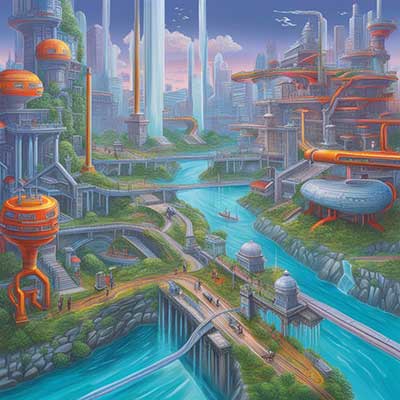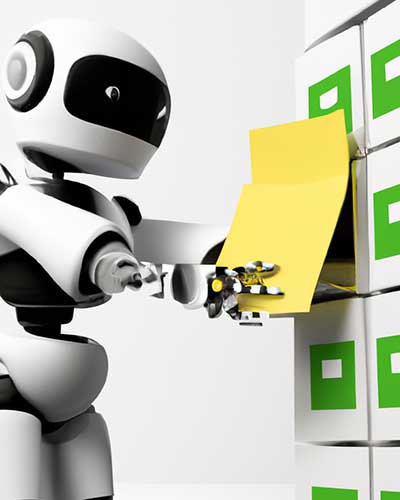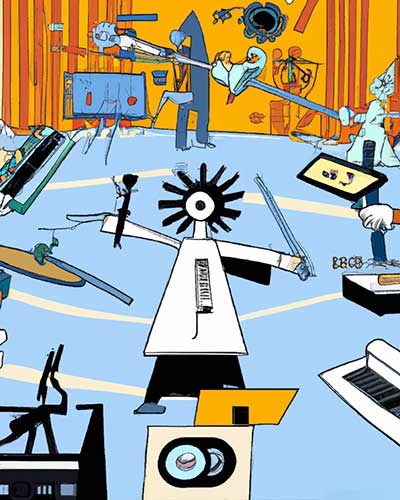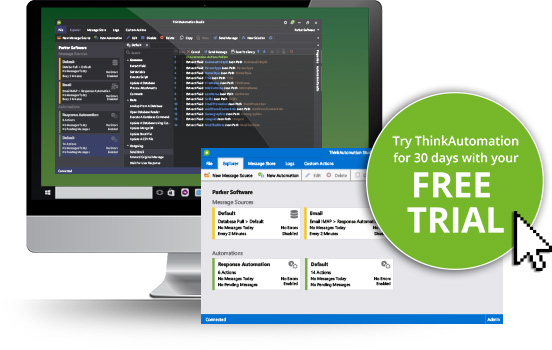Beyond the Basics: Diving Deeper into Digital vs. Robotic Process Automation
Welcome to the fascinating world of business automation! If you've been keeping an ear to the ground, you've probably heard the buzz around two intriguing terms: Digital Process Automation (DPA) and Robotic Process Automation (RPA). At first glance, they might sound like jargon from a sci-fi movie, but trust me, they're reshaping the way businesses operate in the real world. As we stand at the crossroads of technological innovation, it's essential to understand these game-changers. Why? Because they hold the key to unlocking unparalleled efficiency and agility in business operations. Whether you're a tech enthusiast, a business owner, or just someone curious about the future of work, this deep dive into DPA and RPA is for you. So, buckle up and let's embark on this enlightening journey together!

Understanding Process Automation
Ah, automation! It's not just a modern-day marvel; it's a tale as old as time. Think about it. From ancient civilizations using ingenious contraptions to simplify tasks to the industrial revolution's assembly lines, humans have always been on a quest to make work easier, faster, and more efficient. And why not? After all, who doesn't love a bit of convenience?
Fast forward to today, and the digital age has ushered in a new era of automation. With the rise of computers and the internet, businesses have a plethora of tools at their disposal. But with great power comes great responsibility (and a tad bit of confusion). Enter Digital Process Automation and Robotic Process Automation. These aren't just fancy terms to impress at dinner parties; they're the backbone of many modern businesses, driving efficiency and innovation.
But here's the catch: while both DPA and RPA revolve around automation, they're not quite the same. It's like comparing apples to oranges. Both are fruits, sure, but they have distinct flavors, textures, and nutritional profiles. Similarly, DPA and RPA have their unique characteristics, applications, and benefits. Curious to know more? Well, you're in for a treat as we delve deeper into these transformative technologies!
Robotic Process Automation (RPA) Explained
Let's start our deep dive with Robotic Process Automation, or as I like to call it, the "digital workhorse." Picture this: a virtual assistant, tirelessly working behind the scenes, handling tasks with the precision of a seasoned professional. That's RPA in a nutshell.
- Nature & Core Characteristics: RPA is all about mimicking human actions in a digital environment. It's like having a robot (albeit a virtual one) trained to perform specific tasks based on set rules. These bots can interact with software, fill out forms, extract data, and even switch between applications, just like we do.
- Key Applications: Ever received an invoice or a receipt almost instantly after making an online purchase? Chances are, an RPA bot was working its magic. From processing invoices to updating databases and even handling routine customer queries, these bots are everywhere, ensuring things run smoothly.
- Benefits: Time is money, and RPA is the ultimate time-saver. By automating repetitive tasks, businesses can achieve faster turnaround times, reduce errors, and free up human resources for more value-driven activities. Plus, these bots don't need coffee breaks, making them available 24/7!
- Limitations: But, like all things, RPA isn't without its limitations. While they're fantastic at following instructions, these bots aren't great thinkers. They thrive in structured environments but can stumble when faced with anomalies or tasks that require judgment.
In essence, RPA is like that reliable friend who's always there to help with chores. They might not be great at offering life advice, but when it comes to getting things done efficiently, they're your go-to!


Digital Process Automation (DPA) Unveiled
Now, let's shift our focus to Digital Process Automation, the broader sibling in the automation family. If RPA is about the trees, DPA is all about the forest. It's a holistic approach, looking at the bigger picture of business processes and workflows.
- Nature & Core Characteristics: DPA isn't just about automating tasks; it's about transforming entire workflows. It's like giving your business a digital makeover, ensuring processes are streamlined, interconnected, and agile. DPA systems are designed to be adaptive, adjusting to varying inputs and making decisions based on a set of criteria.
- Key Applications: Imagine a new employee joining your company. The onboarding process isn't just about filling out a form. It involves multiple steps, from setting up IT access to scheduling training sessions and ensuring compliance. DPA shines in such scenarios, orchestrating complex, multi-step processes that span departments or even organizations. It ensures that every step, from initiation to completion, is seamless and efficient.
- Benefits: With DPA, businesses can achieve a higher level of operational excellence. Processes become more transparent, bottlenecks are easily identified, and there's a consistent user experience across the board. It's all about agility, ensuring businesses can quickly adapt to changing needs, be it market dynamics, customer preferences, or regulatory changes.
- Limitations: But, as with all things, DPA has its challenges. Implementing it isn't a walk in the park. It often requires deep integrations, a thorough understanding of business processes, and sometimes a cultural shift. It's not just about the technology; it's about people, processes, and change management.
In a nutshell, DPA is like the maestro of an orchestra, ensuring every instrument (or in this case, business function) plays in harmony, delivering a performance that's music to the ears of both businesses and their customers.
ThinkAutomation: The Best of Both Worlds
In the vast universe of automation tools, there's a shining star that stands out: ThinkAutomation by Parker Software. It's not just another platform; it's a symphony of RPA and DPA, harmonizing their strengths to offer businesses a transformative experience.
Versatility at Its Best
ThinkAutomation is like a Swiss Army knife in the world of automation. From monitoring multiple email accounts, databases, and social media feeds to processing intricate documents, its capabilities are vast and varied. Whether you're in sales, healthcare, or customer service, this platform has a solution tailored for you.
Integration with ChatGPT
In today's digital age, AI isn't just a buzzword; it's a game-changer. ThinkAutomation's seamless integration with OpenAI's ChatGPT is a testament to its forward-thinking approach. This feature not only enables businesses to leverage AI capabilities, like classifying emails or extracting critical data, but it also ensures they stay ahead of the curve in this ever-evolving landscape.
Scalability for Every Busines
One size rarely fits all, especially in business. ThinkAutomation gets this. It offers scalability that caters to diverse business needs. Whether you're a budding startup or a global conglomerate, this platform scales to match your ambitions, ensuring you never hit a roadblock in your automation journey.
Real-World Applications
Let's get real for a moment. The true test of any platform is its real-world applications. ThinkAutomation shines here, with features that resonate with actual business challenges. Need to streamline your accounts payable process? Check. Want to automate your unified communications? Done. Looking to host a ChatGPT bot? ThinkAutomation has got you covered.
A Legacy of Excellence
Launched in 2004, ThinkAutomation isn't new to the game. It's been tried, tested, and trusted by thousands of businesses across 100 countries. With a dedicated team continually enhancing its features and integrations, it's a platform that's not just about meeting current needs but also anticipating future challenges.
Pricing & Support
Quality often comes with a hefty price tag, but ThinkAutomation strikes the perfect balance. With editions ranging from Free to Professional, businesses can choose a plan that aligns with their needs and budget. And it's not just about the platform; it's about the entire experience. With premium support options, businesses can be assured of timely assistance, ensuring they make the most of their investment.
In essence, ThinkAutomation is more than just a platform; it's a partner in your automation journey. It's about empowering businesses, big or small, to embrace the future with confidence, ensuring they're always a step ahead in this dynamic world of digital transformation.
The Synergy of RPA and DPA in Modern Business
Imagine a world where RPA and DPA aren't rivals, but partners in crime, working hand in hand to revolutionize the way businesses operate. Sounds dreamy, right? But here's the twist: it's not a dream; it's the reality that forward-thinking businesses are embracing.
- A Seamless Dance: At the heart of this synergy is the understanding that while RPA and DPA have their unique strengths, they're even more powerful when combined. Think of it as a dance. RPA is the precise footwork, handling specific tasks with finesse, while DPA is the choreography, ensuring the entire performance flows seamlessly.
- Real-World Scenarios: Let's dive into a real-world example. Consider a manufacturing company. RPA bots can handle tasks like inventory checks, order placements, and invoice generation. Simultaneously, DPA ensures that the entire supply chain process, from raw material procurement to product delivery, is streamlined and efficient. The result? Faster production cycles, reduced costs, and delighted customers.
- The Role of ThinkAutomation: Enter ThinkAutomation, the maestro orchestrating this beautiful synergy. By offering features that cater to both RPA and DPA needs, it ensures businesses don't have to choose between the two. They get the best of both worlds, wrapped in a user-friendly package.
- Benefits of the Synergy: The combined power of RPA and DPA offers businesses a competitive edge. Processes become agile, errors reduce dramatically, and there's a significant boost in efficiency. Moreover, employees, freed from mundane tasks, can focus on strategic, value-driven activities, fostering innovation and growth.
- Challenges & Solutions: Of course, integrating RPA and DPA isn't without its challenges. From ensuring seamless data flow between systems to training employees, there's a lot to consider. But with platforms like ThinkAutomation, businesses have a trusted ally, offering tools, support, and expertise to navigate these challenges with ease.
In conclusion, the synergy of RPA and DPA isn't just a trend; it's the future. And businesses that recognize and harness this synergy are set to lead, innovate, and thrive in the modern digital era.


Future Trends: The Road Ahead in Automation
As we stand at the crossroads of the present and the future, the landscape of automation is shimmering with possibilities. The fusion of RPA and DPA is just the beginning. The horizon holds promises of even more groundbreaking innovations that will redefine how businesses operate.
- AI and Machine Learning: The next frontier in automation is undoubtedly AI and Machine Learning. Imagine RPA bots that don't just follow rules but learn and adapt over time. These intelligent bots could predict market trends, offer personalized customer experiences, and even make data-driven decisions, all in real-time.
- Hyperautomation: A term that's been making waves recently, hyperautomation is all about pushing the boundaries. It's the amalgamation of RPA, DPA, AI, machine learning, and other advanced technologies to create ultra-efficient, self-evolving business processes. It's not just about doing things faster but smarter.
- Human-Bot Collaboration: The future isn't about robots replacing humans; it's about collaboration. Envision a workspace where bots handle repetitive tasks, while humans focus on creative, strategic endeavors. This synergy could foster unparalleled innovation, with bots offering data-driven insights and humans providing the creative spark.
- The Role of ThinkAutomation: As the world gears up for these exciting trends, ThinkAutomation is poised to be at the forefront. With its robust features, AI integrations, and commitment to innovation, it's set to empower businesses to navigate the future with confidence and agility.
The road ahead in automation is paved with opportunities. As technologies evolve and converge, businesses that stay informed, adaptive, and proactive will not just survive but thrive. And with platforms like ThinkAutomation, they have the perfect co-pilot for this exhilarating journey.
Embracing the Automation Revolution with ThinkAutomation
As we wrap up this enlightening journey through the realms of RPA, DPA, and the promising future of automation, one thing is clear: the automation revolution is here, and it's transforming the business world in ways we could only dream of a decade ago.
The nuances between RPA and DPA, while intricate, are crucial for businesses to grasp. It's not just about understanding definitions but about recognizing the potential each holds and how they can harmoniously coexist to drive unparalleled efficiency.
Enter ThinkAutomation, the beacon in this vast automation landscape. Developed by the visionary team at Parker Software, it's not just a tool; it's a comprehensive solution designed to cater to the unique needs of modern businesses. From its robust features to its commitment to innovation, ThinkAutomation is the embodiment of what the future of automation looks like.
For businesses, the message is loud and clear: Embrace automation, but do it wisely. Understand the tools at your disposal, recognize their strengths, and leverage them to their full potential. And as you embark on this exciting journey, remember that with ThinkAutomation by your side, the sky's the limit.
Thank you for joining us on this exploration. Here's to a future where businesses operate smarter, faster, and with a touch of automation magic!

